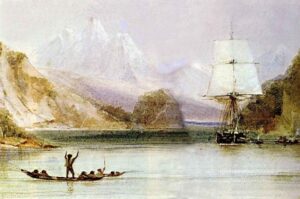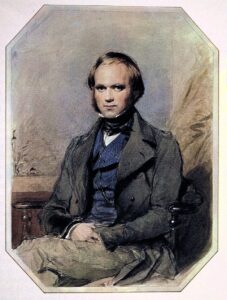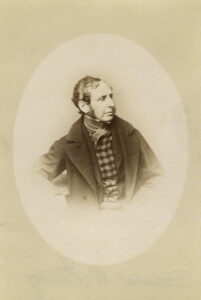

The arrival of the Dutch tall ship Oosterschelde in Falmouth this July marked the end of an extraordinary voyage that retraced one of history’s most famous scientific expeditions.
By Linda Batchelor
On Saturday 19 July 2025 the Dutch Tall Ship Oosterschelde arrived in Falmouth marking the end of the Darwin 200 Global Voyage 2023-2025. The voyage of 43,000 nautical miles, and thirty-one ports of call, mirrored much of the 1831- 1836 expedition route of HMS Beagle. The arrival was significant since both ships made their initial landfall in England at Falmouth on return from their expeditions.
The Oosterschelde had left Plymouth on 14 August 2023 on a Darwin inspired voyage around the world making landfall in key locations visited by the ship and its expedition naturalist Charles Darwin. The Darwin 200 Global Voyage is a global conservation initiative focussed on engaging a global audience, conducting research and training young conservationists.
Oosterschelde was built in the Netherlands and completed in 1918. The restored ship is a three masted topsail schooner with a 36 metre centre mast and 900 square metres of sail and can carry a crew of twenty-four.
HMS Beagle

HMS Beagle in Ponsonby Sound, Tierra del Fuego March 1834. Conrad Martens (1801-1878) Painted during the voyage of the Beagle by Martens, the ship’s artist and draughtsman.
The ship, built for the Royal Navy as a 10 gun brig sloop was launched in 1820 on the Thames at Woolwich and converted soon after to serve as a survey vessel. From 1826 to 1830 the vessel undertook a voyage to conduct a hydrographic survey of the South American waters of Patagonia and Tierra del Fuego. It was during the voyage that the Beaufort Wind Force Scale invented by Francis Beaufort, the Admiralty Hydrographer of the Navy, was used for the first time.
In 1828 temporary command of the expedition passed to Robert FitzRoy following the suicide during the voyage of the Captain Pringle Stokes. HMS Beagle returned to England in 1830 having established Captain FitzRoy’s reputation as a surveyor and a commander.
When a second Beagle voyage to survey the Southern Ocean was proposed in 1831, FitzRoy was recommended as commander of the expedition by Admiral Beaufort. The vessel was refitted with a third mast and more space below decks for scientific work and instruments. Alongside the naval officers and crew who would conduct the hydrographic survey a group of civilian personnel were recruited to assist with the wider scientific interests. Charles Darwin was part of this group, recruited primarily as a naturalist to study and collect specimens of flora, fauna and geological formations from the areas visited. Darwin was also to fill the part of gentleman companion to FitzRoy who was advised to take such a person with him on the voyage to avoid the typical loneliness and responsibility for a commander of naval surveying.
Darwin was not the first choice for this position and there were initially doubts on both sides from both FitzRoy and Darwin. The two came from differing social backgrounds which shaped their views, particularly their political and religious outlooks. Routes to the expedition had also been different. FitzRoy had come through the Royal Navy from Midshipman to Captain. He was there through professional training and ability and was employed as a serving naval officer by the Admiralty to conduct hydrographic exploration. Darwin had come to the position on recommendation from the Professor of Botany at Cambridge John Henslow for his ‘zeal and enterprize’ but ‘unfinished’ in formal training as a naturalist and his place was self-funded. There were, however, some similarities between the two men. They were both young, Darwin was twenty-two and FitzRoy was twenty-seven, both had lost their mothers during boyhood and had supportive family connections. They both had intelligence and a tremendous work ethic and they shared a mutual interest in the science of the natural world and the opportunities offered by the global expedition.
It was on that basis it was decided that Darwin would join FitzRoy on the expedition which set out from Plymouth on 27 December 1831.
Captain FitzRoy
Captain Robert FitzRoy was born in 1805 in Suffolk into an aristocratic and wealthy family with many social and political connections. His family were directly related to Charles II through his paternal grandfather the 3rd Duke of Grafton and his maternal grandfather was the 1st Marquess of Londonderry.
In 1818 he attended the Royal Naval College at Plymouth and entered the Royal Navy in 1819 beginning a successful naval career. He served on various ships on the South America Station rising from Midshipman to Lieutenant by 1824 when he passed his promotion examinations with 100%, the first officer to do so. He was still serving in South America when he was asked in 1828 to take over temporary command of HMS Beagle, then engaged in a hydrographic survey of Tierra del Fuego, following the suicide of the previous captain.
On Beagle’s return to England in 1830 he stood unsuccessfully for Parliament in May 1831 as the Tory candidate for Ipswich. However, with influence from his powerful relatives he was soon re-appointed as commander of the second expedition of HMS Beagle to become what Darwin described in a letter to his sister Susan as “my beau ideal of a Captain”.
FitzRoy was a perfectionist and meticulous in his record keeping, sometimes returning to waters already surveyed to check findings. At times he would follow his own ends rather than Admiralty orders and the expedition intended for two years eventually took five. He had strong viewpoints, often took criticism badly and and was known to be hot tempered and sometimes lost control in anger, as Darwin noted “to the point of insanity”. Nevertheless, the expedition was successful in outcome and returned to England to acclaim in 1836 having gathered a vast amount of scientific information.
Charles Darwin
Darwin was from a family of doctors with wide ranging scientific and philosophical interests. He was born in Shrewsbury in 1809 a grandson of Erasmus Darwin one of the Lunar Men of the eighteenth century, a physician, a poet and natural philosopher. On his mother’s side he was from the Wedgewood family of potters. The family were liberal and progressive in their views who were prominent abolitionists and encouraged freedom of thinking.
After his time at Shrewsbury School Charles had first attended Edinburgh University from 1825 to study medicine but he disliked some aspects such as surgery and neglected his studies to his father, Robert’s, annoyance and regret. In 1828 Charles was sent to Christ Church College Cambridge to study for a Bachelor of Arts with a view to becoming an Anglican clergyman. Whilst at Cambridge the focus of his studies shifted towards natural science especially the study of birds and insects. He encountered the teaching of tutors such as John Henslow, Professor of Botany and Adam Sedgwick, Professor of Geology and led a busy life both academic and social.

Charles Darwin 1840 Watercolour by George Richmond (1809 -1896) Down House, Kent
In 1831 he was offered the chance by Professor Henslow to travel around the world on the expedition of HMS Beagle with Captain Robert FitzRoy. Despite initial uncertainty on both sides and objections from Robert Darwin it was agreed that Charles should join. Charles was appointed by the Admiralty to the position as Naturalist but funded by his father which allowed him independence from officialdom and ownership of collections made during the voyage.
Darwin was concerned with the conditions he would face when he joined the ship but he wrote with relief to his sister Susan on his arrival that his cabin was “a capital one, certainly next best to the Captain’s and remarkably light”. He also told her that he was sharing the cabin and “My companion most luckily I think will turn out to be the officer whom I shall like best”.
This officer was John Lort Stokes with whom Darwin got on well. At this time he was a young naval officer close in age to Darwin who was assistant surveyor to FitzRoy on the second expedition. He had been on the crew of Beagle since 1825 and he was to serve there for nearly eighteen years taking over the ship’s command in 1841 to survey the waters of Timor and New Zealand.
Darwin was named “Philos” by FitzRoy by which he became generally known to those on the expedition. Whilst the crew of the ship were surveying around and off the coast of the areas in which they were engaged Darwin was often inland recording flora and fauna and collecting samples of flora and specimens of insects and fossils
He sent his first box of specimens to England from Montevideo on the Falmouth packet ship Emulous in August 1832. He sent a letter to Henslow (Darwin Correspondence Project Letter No.178) saying “The specimens are now ready to be sent off most probably by the Packet and if so they go to Falmouth (where FitzRoy has made arrangements)”. Again in November 1832 he sent a consignment of fossils from Montevideo with the Falmouth Packet Duke of York under Captain Snell. When the Packet ship left port according to the diary of the ship’s Surgeon James Williamson they “set sail in company with HM Surveying Barque Beagle”.
The surveying and charting of the waters of the Southern oceans and the study of the natural world in areas of South America and islands such as the Galapagos continued with the same level of commitment to building knowledge of the natural world throughout the entire expedition.
FitzRoy and Darwin after HMS Beagle
After the expedition concluded FitzRoy wrote a detailed account of the voyage and its findings. In 1843 he served as the second Governor of New Zealand, a position he held (not without controversy) until 1845.
By 1850 he had retired from active naval service and the following year he was elected as a Fellow of the Royal Society on the recommendation of thirteen Fellows including Charles Darwin. He developed his interest in meteorology fuelled by his experience as a sailor, surveyor, hydrographer and the expeditions of HMS Beagle. There was a growing international drive to improve knowledge and understanding of maritime meteorology and when in 1854 the Board of Trade established a Meteorological Department, set up as a service to mariners to improve the safety of life and property at sea, FitzRoy was appointed as its chief.
As head of the Meteorological Department Fitzroy worked to improve the scientific study of weather using synoptic forecasting and developing the observation network to make such information more publicly available. He championed the maintenance of scientific weather reporting, produced detailed reports and charts and developed daily weather predictions which he called ‘forecasts’.
However, despite these advances and the public popularity for weather forecasting, there was constant criticism from some in the scientific community who did not believe it was possible to predict the weather and doubted many of FitzRoy’s methods. FitzRoy’s health, physical and mental, suffered and he was frequently absent from his office. On 30 April 1865 he took his own life.

Robert FitzRoy Early 1860s. Photographic Print. National Portrait Gallery. By London Stereoscopic & Photographic Company, albumen print on card mount, early-mid 1860s.
On Darwin’s on return to England after visiting his family in Shrewsbury he went to London as his sister Caroline wrote to a relative “to be on the spot when his things are taken out of the Beagle”. In the same letter Caroline stated, “now I can allow he has gained happiness and interest for the rest of his life”. (DCP letter no.308)
In London he worked on analysing his observations, his findings and his extensive collections. He did so for the rest of his life, publishing his findings and theories extensively including his ‘Voyage of the Beagle’ and became a celebrated naturalist and geologist. His observations from Beagle particularly from the Galapagos Islands led to the development of his theory of evolution by natural selection as early as 1842 and published in the 1859.
Return to Falmouth, England
HMS Beagle returned to England after an absence of five years on 2 October 1836. Darwin recorded that “After a tolerably short passage but some very heavy weather we came to anchor at Falmouth”.
Captain FitzRoy was entertained in the home of Robert Were Fox who as well as being a senior member of the of the Falmouth firm of G C Fox & Sons of Ship Agents, was a Fellow of the Royal Society. He was a natural philosopher, a geologist and an inventor, most notably of the Fox’s Dipping Needle used for magnetic observations.
Robert’s son, Barclay recorded the occasion in his diary “Captain Fitzroy of the Beagle dined here. He is just returned from a 5 years’ voyage of discovery of about the Southern regions. My father showed him his dipping needle &c. with which he was highly pleased. Capt. F. breakfasted here & reports that he was not able to sleep from the philosophical excitement of last evening.”
Darwin did not stop in Falmouth but on arrival on 2 October “the same night (and a dreadfully stormy one) I started by the Mail for Shrewsbury.” He would, however, become the most famous, despite missing out on the ‘philosophical excitement of the evening’.
For Further Reading:
NMMC Bartlett Blog Weather Watching
NMMC Bartlett Blog Packet Ship Passengers
NMMC Maritime Views Focus on Falmouth ‘A very nice Middy’ Daniel Pender
NMMC Maritime Views Footnote to History The Arrival of The Beagle
The Bartlett Blog is researched, written and produced by volunteers who staff The Bartlett Maritime Research Centre and Library of National Maritime Museum Cornwall. This blog post was written by Linda Batchelor, a Bartlett Library volunteer.
The Bartlett Maritime Research Centre & Library holds a Collection of over 20,000 volumes and offers access to one of the finest collections of maritime reference books, periodicals and archival material. The Bartlett Blog reflects the diversity of material available in The Bartlett Library.

National Maritime
Museum Cornwall Trust
Discovery Quay
Falmouth Cornwall
TR11 3QY
View Map
See our opening hours
Tel: +44(0)1326 313388
Email: enquiries@nmmc.co.uk